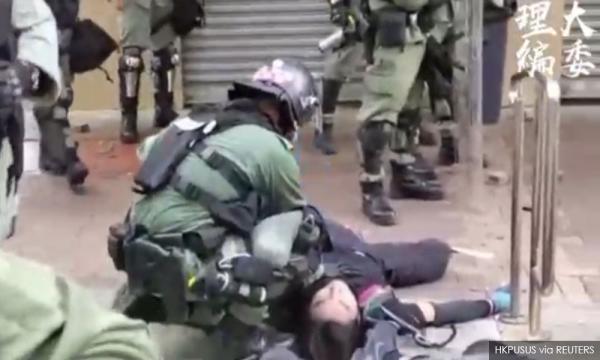Hong Kong police shot and wounded a teenage boy on Friday, as violent protests erupted across the Chinese-ruled city hours after its embattled leader Carrie Lam invoked colonial-era emergency powers last used more than 50 years ago.
Lam, speaking at a news conference, said a ban on face masks would take effect on Saturday under the emergency laws that allow authorities to “make any regulations whatsoever” in whatever they deem to be in the public interest.
Nearly four months of anti-government protests have plunged Hong Kong into its biggest political crisis since its handover from Britain to China in 1997 under a “one country, two systems” formula that granted it autonomy and broad freedoms not enjoyed on the mainland.
The Beijing-backed leader said the banning of face masks was necessary to quell escalating violence and didn’t rule out the prospect of further measures if the unrest continued.
But the move only enraged protesters, who took to the streets as darkness fell to vent their anger.
Sirens echoed through the streets as protesters set fires, hurled petrol bombs at police and burned the Chinese national flag, in a direct challenge to authorities in Beijing.
Police said an officer in Yuen Long, a district in the outlying New Territories that saw fierce clashes in July, had fired a shot in self-defence after a protester threw a petrol bomb at him, setting him on fire.
Local media reported a 14-year-old boy had been shot and the city’s Hospital Authority said a 14-year-old was in a serious condition, without giving further details.
Around a hundred demonstrators besieged a Bank of China (HK) branch in the high-end shopping district of Causeway Bay, while across the harbour in Kowloon district protesters smashed the glass storefront of a China Life branch.
Police fired volleys of tear gas to disperse protesters in flashpoint districts across the territory, including Causeway Bay, Sha Tin and Wong Tai Sin, underscoring the challenges facing authorities as the protests show no sign of letting up.
‘Colour revolution’
China’s Hong Kong and Macao Affairs Office praised Lam’s move in a statement that said the protests were evolving into a “colour revolution”, a term coined to refer to popular uprisings in Ukraine and other former Soviet states that swept away long-standing rulers, with interference from external forces.
The emergency laws allow curfews, censorship of the media, and control of harbours, ports and transport, although Lam did not specify any particular action that might follow beyond the mask ban.
Shopping malls, banks and shops across Hong Kong island had closed early in anticipation of violence as some protesters burned Chinese flags and chanted “You burn with us”, and “Hong Kongers, revolt”.

“The anti-mask law has become a tool of tyranny,” said Samuel Yeung, an 18-year-old university student, as crowds swelled in the main financial district of Central, beneath gleaming skyscrapers that house the Asia headquarters of companies including HSBC.
“They can make use of the emergency law to enact any policies or laws that the government wants. There’s no rule of law anymore. We can only be united and protest.”
What began as opposition to a proposed extradition law, which could have seen people sent for trial in mainland courts, has grown into a broad pro-democracy movement and a serious challenge to Chinese leader Xi Jinping.
The protesters are angry about what they see as creeping interference by Beijing in their city’s affairs. China dismisses accusations it is meddling and has accused foreign governments, including the United States and Britain, of stirring up anti-China sentiment.
Many protesters wear masks to hide their identity due to fears employers could face pressure to take action against them as companies walk a tightrope between the anti-government activists and the city’s political masters in Beijing.
“Almost all protesters wear masks, with the intention of hiding their identity. That’s why they have become more unbridled,” said Lam.
“We can’t keep the existing regulations idle and let violence escalate and the situation continue to deteriorate.”
Lam described the territory as being in serious danger, but not in a state of emergency.
Pro-Beijing groups had been pushing for a mask ban, but it was not clear how the government would implement it in a city where many of its 7.4 million residents wear them every day to protect against infection following the outbreak of the deadly Severe Acute Respiratory Syndrome (SARS) in 2003.
‘Something drastic’
Authorities had already loosened guidelines on the use of force by police, according to documents seen by Reuters.
That came just before an escalation in violence on Tuesday, the 70th anniversary of the founding of the People’s Republic of China, when police fired about 1,800 volleys of tear gas, 900 rubber bullets and six live bullets - one of which hit an 18-year-old, the first time a protester had been hit by live fire.
The student, Tony Tsang, was shot at close range as he fought with a police officer. He is stable in hospital and has been charged with rioting, which carries a maximum 10-year sentence, and assaulting an officer.
Pro-democracy campaigners condemned Lam’s latest decision.
“This is an ancient, colonial set of regulations, and you don’t use them unless you can’t legislate anymore,” said Martin Lee, a veteran activist and one of the city’s most prominent lawyers. “Once you start, there’s no end to it.”
Some Hong Kong’s businesses, struggling with a dip in tourism and retail sales due to the protests, gave the law a warmer welcome.
“I agree with it at this point,” said businessman Allan Zeman, who is also an economic adviser to Lam. “You have to do something drastic to end the violence.”
- Reuters
Explainer: HK's controversial anti-mask ban and emergency regulations



